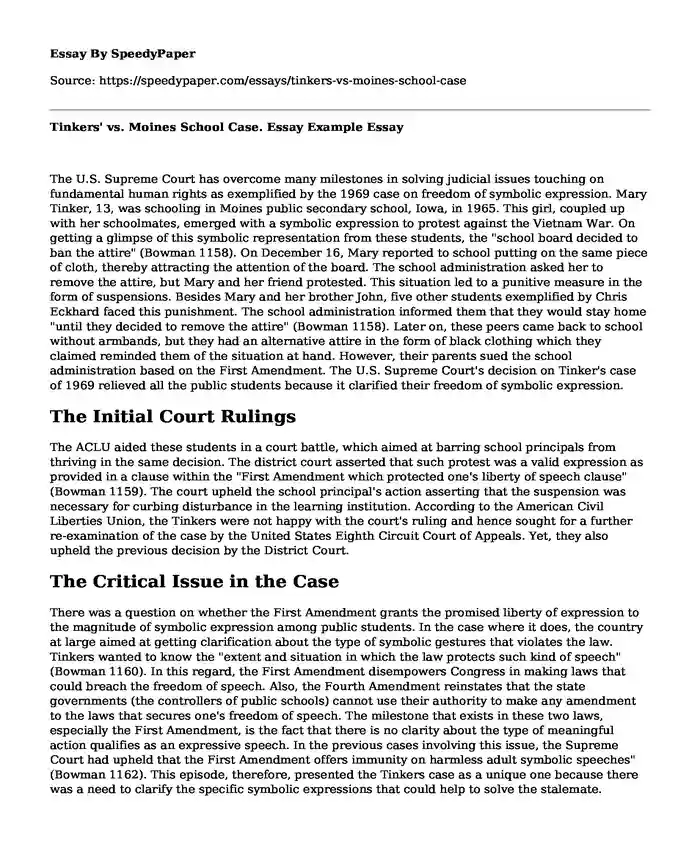
| Type of paper: | Essay |
| Categories: | School Court system Civil rights Vietnam War |
| Pages: | 3 |
| Wordcount: | 775 words |
The U.S. Supreme Court has overcome many milestones in solving judicial issues touching on fundamental human rights as exemplified by the 1969 case on freedom of symbolic expression. Mary Tinker, 13, was schooling in Moines public secondary school, Iowa, in 1965. This girl, coupled up with her schoolmates, emerged with a symbolic expression to protest against the Vietnam War. On getting a glimpse of this symbolic representation from these students, the "school board decided to ban the attire" (Bowman 1158). On December 16, Mary reported to school putting on the same piece of cloth, thereby attracting the attention of the board. The school administration asked her to remove the attire, but Mary and her friend protested. This situation led to a punitive measure in the form of suspensions. Besides Mary and her brother John, five other students exemplified by Chris Eckhard faced this punishment. The school administration informed them that they would stay home "until they decided to remove the attire" (Bowman 1158). Later on, these peers came back to school without armbands, but they had an alternative attire in the form of black clothing which they claimed reminded them of the situation at hand. However, their parents sued the school administration based on the First Amendment. The U.S. Supreme Court's decision on Tinker's case of 1969 relieved all the public students because it clarified their freedom of symbolic expression.
The Initial Court Rulings
The ACLU aided these students in a court battle, which aimed at barring school principals from thriving in the same decision. The district court asserted that such protest was a valid expression as provided in a clause within the "First Amendment which protected one's liberty of speech clause" (Bowman 1159). The court upheld the school principal's action asserting that the suspension was necessary for curbing disturbance in the learning institution. According to the American Civil Liberties Union, the Tinkers were not happy with the court's ruling and hence sought for a further re-examination of the case by the United States Eighth Circuit Court of Appeals. Yet, they also upheld the previous decision by the District Court.
The Critical Issue in the Case
There was a question on whether the First Amendment grants the promised liberty of expression to the magnitude of symbolic expression among public students. In the case where it does, the country at large aimed at getting clarification about the type of symbolic gestures that violates the law. Tinkers wanted to know the "extent and situation in which the law protects such kind of speech" (Bowman 1160). In this regard, the First Amendment disempowers Congress in making laws that could breach the freedom of speech. Also, the Fourth Amendment reinstates that the state governments (the controllers of public schools) cannot use their authority to make any amendment to the laws that secures one's freedom of speech. The milestone that exists in these two laws, especially the First Amendment, is the fact that there is no clarity about the type of meaningful action qualifies as an expressive speech. In the previous cases involving this issue, the Supreme Court had upheld that the First Amendment offers immunity on harmless adult symbolic speeches" (Bowman 1162). This episode, therefore, presented the Tinkers case as a unique one because there was a need to clarify the specific symbolic expressions that could help to solve the stalemate.
The Supreme Court's Final Ruling
The United States Supreme Court accepted the Tinkers' appeal to determine the ban against symbolic expression. At the beginning of 1969, the highest court on American soil presented its verdict concerning this case. Here, the court explained that learners could not lose their legal privileges of speech in the school environment. The ruling indicated that the First Amendment was applicable to public schools, and its officials "could not prohibit student speech unless it has a disruptive impact on the process of education" (Bowman 1164). Here, the act of Tinkers and their peers wearing a black armband had no disruptive effects on learning means that the First Amendment protects them.
Conclusion
This ruling shaped the judicial and civil society over the freedom of speech because it defended the rights of students to engage in any form of symbolic expression provided they are harmless to education and other school-based activities. Since the 1969 ruling, many courts have solved many cases specifically by quoting Tinker v. Moines Independent Community School District.
Works Cited
American Civil Liberties Union. Tinker vs. Des Moines - Landmark Supreme Court ruling on behalf of student expression. ACLU, 2011. https://www.aclu.org/other/tinker-v-des-moines-landmark-supreme-court-ruling-behalf-student-expression
Bowman, K. The civil rights roots of Tinker's disruption tests. Michigan University, September 2009. https://www.researchgate.net/publication/228322392_The_Civil_Rights_Roots_of_Tinker's_Disruption_Tests/link/551415c80cf283ee0834a45b/download
Cite this page
Tinkers' vs. Moines School Case. Essay Example. (2023, Apr 19). Retrieved from https://speedypaper.com/essays/tinkers-vs-moines-school-case
Request Removal
If you are the original author of this essay and no longer wish to have it published on the SpeedyPaper website, please click below to request its removal:
- Nursing Essay Sample: Principles of Shared Governance
- Advantages of the Internet Technology Essay Sample
- Free Essay on the Great Debaters Movie Research
- Media Literacy Analysis Essay, Free Sample for Everyone
- Free Essay Example - Mentoring and Coaching Reflection
- Summary of Telehealth (Care on Demand). Paper Example
- Essay Sample on Promotional Marketing Campaign for Savanah Bananas
Popular categories




